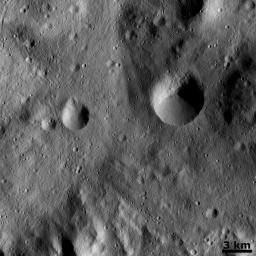This Dawn framing camera (FC) image of Vesta shows a slightly curved chain of small craters in the bottom half of the image. The chain is approximately 1 kilometer (0.6 mile) wide and extends for roughly 20 kilometers (12 miles) in this image. But it is longer than this and extends out of the field of view of the image. This chain is located on the floor of Vesta's large south-polar impact structure, Rheasilvia. The chain was most likely created by material ejected during the formation of a larger crater outside of the imaged area. Offset from the center of the image is a crater that has one side that is fresher and distinct and one side that is less distinct and more degraded. This crater is similar in morphology to Helena crater, which has been in the two previous images of the day.
This image is located in Vesta's Rheasilvia quadrangle, near Vesta's south pole. NASA's Dawn spacecraft obtained this image with its framing camera on Dec. 18, 2011. This image was taken through the camera's clear filter. The distance to the surface of Vesta is 280 kilometers (174 miles) and the image has a resolution of about 25 meters (82 feet) per pixel. This image was acquired during the LAMO (low-altitude mapping orbit) phase of the mission.
The Dawn mission to Vesta and Ceres is managed by NASA's Jet Propulsion Laboratory, a division of the California Institute of Technology in Pasadena, for NASA's Science Mission Directorate, Washington D.C. UCLA is responsible for overall Dawn mission science. The Dawn framing cameras have been developed and built under the leadership of the Max Planck Institute for Solar System Research, Katlenburg-Lindau, Germany, with significant contributions by DLR German Aerospace Center, Institute of Planetary Research, Berlin, and in coordination with the Institute of Computer and Communication Network Engineering, Braunschweig. The Framing Camera project is funded by the Max Planck Society, DLR, and NASA/JPL.
More information about the Dawn mission is online at http://www.nasa.gov/dawn and http://dawn.jpl.nasa.gov.

 Planetary Data System
Planetary Data System












